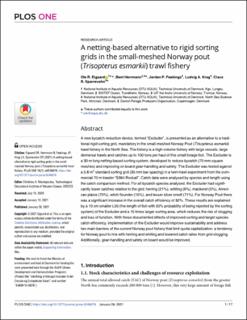| dc.contributor.author | Eigaard, Ole R. | |
| dc.contributor.author | Herrmann, Bent | |
| dc.contributor.author | Feekings, Jordan | |
| dc.contributor.author | Krag, Ludvig Ahm | |
| dc.contributor.author | Sparrevohn, Claus R. | |
| dc.date.accessioned | 2021-05-26T13:50:30Z | |
| dc.date.available | 2021-05-26T13:50:30Z | |
| dc.date.created | 2021-05-16T12:22:51Z | |
| dc.date.issued | 2021-01-28 | |
| dc.identifier.citation | PLOS ONE. 2021, 16 (1), 1-19. | en_US |
| dc.identifier.issn | 1932-6203 | |
| dc.identifier.uri | https://hdl.handle.net/11250/2756499 | |
| dc.description.abstract | A new bycatch reduction device, termed “Excluder”, is presented as an alternative to a traditional rigid sorting grid, mandatory in the small-meshed Norway Pout (Trisopterus esmarkii) trawl fishery in the North Sea. The fishery is a high-volume fishery with large vessels, large demersal trawls and catches up to 100 tons per haul of this small forage fish. The Excluder is a 30 m long netting-based sorting system, developed to reduce bycatch (70 mm square meshes) and improving on board gear-handling and safety. The Excluder was tested against a 5.8 m2 standard sorting grid (35 mm bar spacing) in a twin-trawl experiment from the commercial 70 m trawler “S364 Rockall”. Catch data were analysed by species and length using the catch comparison method. For all bycatch species analysed, the Excluder had significantly lower catches relative to the grid: herring (21%), whiting (6%), mackerel (5%), American plaice (70%), witch flounder (15%), and lesser silver smelt (71%). For Norway Pout there was a significant increase in the overall catch efficiency of 32%. These results are explained by a 10 cm smaller L50 (the length of fish with 50% probability of being rejected by the sorting system) of the Excluder and a 15 times larger sorting area, which reduces the risk of clogging and loss of function. With these documented effects of improved sorting and target species catch efficiency, implementation of the Excluder would improve sustainability and address two main barriers of the current Norway pout fishery that limit quota capitalization; a tendency for Norway pout to mix with herring and whiting and lowered catch rates from grid-clogging. Additionally, gear-handling and safety on board would be improved. | en_US |
| dc.description.sponsorship | : We wish to thank the Ministry of environment and food of Denmark for funding the work presented here through the GUDP (Green Development and Demonstration Program) (Project title “Udvikling af bifangst Excluder til det Danske og Europæiske fiskeri” and number “34009-14-0876”). | en_US |
| dc.language.iso | eng | en_US |
| dc.rights | Navngivelse 4.0 Internasjonal | * |
| dc.rights.uri | http://creativecommons.org/licenses/by/4.0/deed.no | * |
| dc.title | A netting-based alternative to rigid sorting grids in the small-meshed Norway pout (Trisopterus esmarkii) trawl fishery | en_US |
| dc.type | Journal article | en_US |
| dc.type | Peer reviewed | en_US |
| dc.description.version | publishedVersion | en_US |
| dc.rights.holder | © 2021 Eigaard et al. This is an open access article distributed under the terms of the Creative Commons Attribution License, which permits unrestricted use, distribution, and reproduction in any medium, provided the original author and source are credited | en_US |
| dc.source.pagenumber | 1-19 | en_US |
| dc.source.volume | 16 | en_US |
| dc.source.journal | PLOS ONE | en_US |
| dc.source.issue | 1 | en_US |
| dc.identifier.doi | 10.1371/journal.pone.0246076 | |
| dc.identifier.cristin | 1910239 | |
| cristin.ispublished | true | |
| cristin.fulltext | original | |
| cristin.qualitycode | 1 | |

